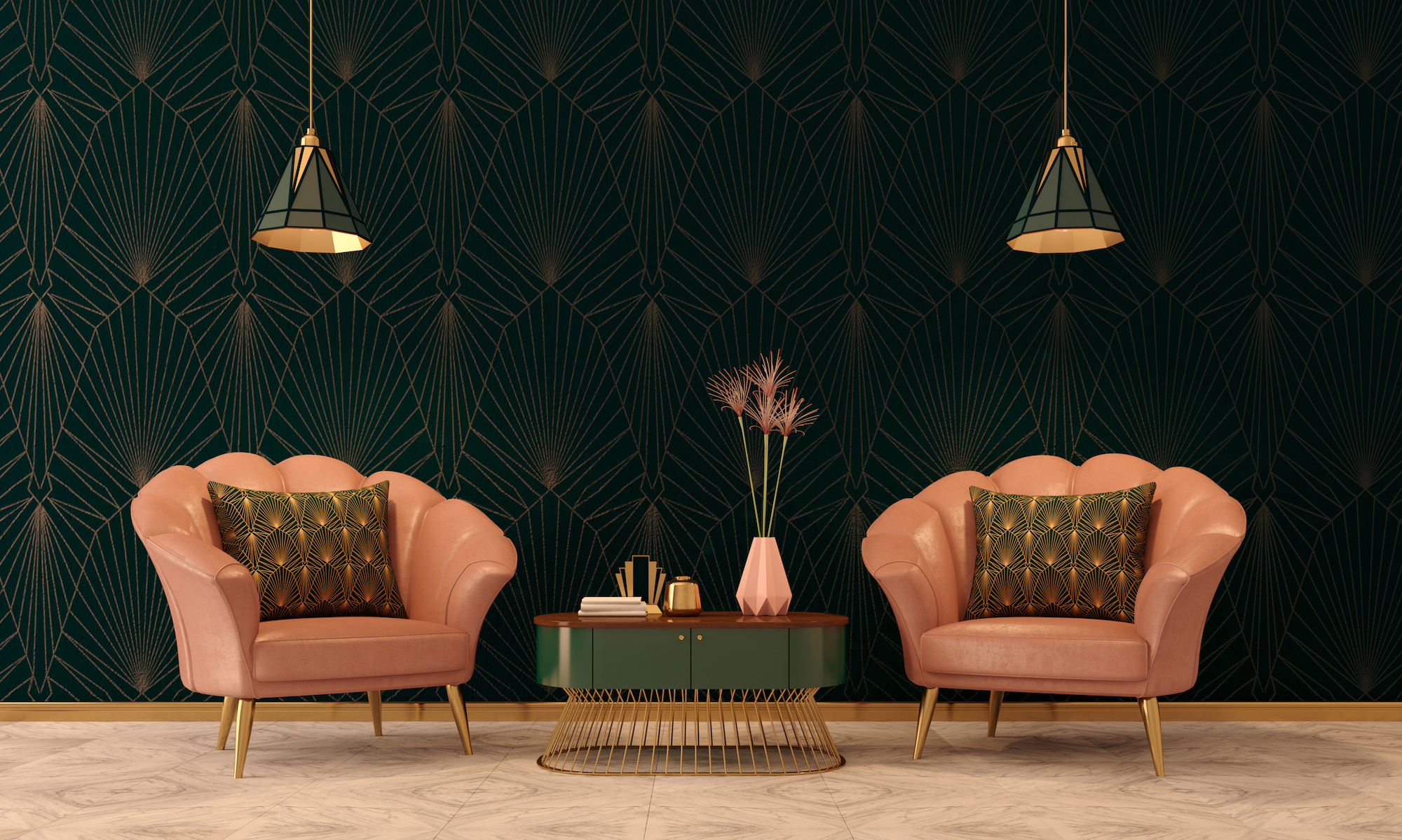What is Art Deco design and architecture?
If you’ve ever gazed upon the New York City skyline—whether IRL or not—and admired the Chrysler Building in particular, you may be a fan of Art Deco design. Ornate but not whimsical, opulent yet practical, this style was born during the 1920s and was in vogue until around 1940.
The decadence of the design style was inspired by the Roaring Twenties and the rise of industry in Europe and the United States, but its heyday was short-lived due in part to the Great Depression in the following decade. he Art Deco movement continues to loom large in the imaginations of consumers and designers alike, and continues to inspire creatives today.

Table of contents
What characterizes Art Deco design and architecture?The origins of Art DecoArt Deco vs. art nouveauHow to decorate in the Art Deco styleWhat characterizes Art Deco design and architecture?
The hallmarks of Art Deco design are symmetry, geometric patterns, rigid lines, and shimmery surfaces, which work together to create a decadent feel. In Art Deco architecture, structural scale and strength also display a close relationship with industrialization.
Most landmarks of Art Deco architecture are commercial buildings. The Chrysler Building, designed by William van Alen, is a good example of Art Deco in the public sphere. The Chrysler Building is considered, more specifically, streamline nouveau, a sub-style within Art Deco that borrowed shapes and textures from the industrial world, mimicking the design of ships, trains, airplanes, and other industrial forms. Other examples of Art Deco architecture include Rockefeller Center, the American Radiator Building, the General Electric Building, and even the Empire State Building.
In smaller-scale Art Deco style design, such as poster art or fabrics, real-life scenes become stylized and flattened but no less luxurious. In fact, the artist’s rendering elevates the design by reducing it to its most striking elements.
The origins of Art Deco
While the Art Deco movement is thought to have originated in Paris in the early 1920s, it wasn’t officially on the cultural map until its debut at the Exposition Internationale des Arts Decoratifs et Industriels Modernes—that is, the International Exhibition of Modern Decorative and Industrial Arts, a World’s Fair held in Paris in 1925.
Not only did the fair give birth to the name “Art Deco” (short for Arts Décoratifs, or decorative arts), it also introduced the world to some of the furniture designers and modern architecture that would influence the field of avant garde visual arts for years to come.
Art Deco vs. art nouveau
The Art Deco style is also inextricably linked to the art nouveau movement, which lasted from roughly 1890 to 1910 around the world. Art nouveau was an attempt by artists to break down the separation between the fine arts and the everyday. As such, much of the work produced during the art nouveau period was the work of craftsmen who incorporated an artistic flair into their furniture or textile design (think of the work of artists William Morris or Gustav Klimt).
How can you tell at a glance what’s Art Deco and art nouveau? Art Deco features more geometric shapes with rigid lines and an industrial feel, while art nouveau is whimsical and a bit more feminine.

How to decorate in the Art Deco style
Channel your inner interior designer with these tips on transforming your home—whether it’s a studio apartment or a three-bedroom condo—into an Art Deco masterpiece.
Develop a taste for heavy metal
While styles such as mid-century modern often feature wood, a smart way to mimic the feel of the Art Deco movement in any type of apartment building is by purchasing metal furniture. Where you might have once bought a wooden bookshelf, try a sleek metal-and-glass shelving unit. Consider a glass-top metal dining table with metal bistro chairs or an up-cycled metal school desk.
To prevent your home from feeling too much like an office building, add plenty of throw pillows and blankets to your living room, or consider adding an opulent shag rug or sheepskin.
Get print happy
Prints were a big part of Art Deco design and maximalism. Incorporating prints and patterns into textiles like throw pillows, towels, and bedding can help bring some of the shapes of the period into play in a direct way. When choosing a pattern, go for stylized, sleek, and geometric art with a color palette that’s a bit muted—think moody greys, mustard yellows, olive greens, and soft blacks.
Finding, framing, and hanging prints like a vintage advertisement for the World Fair or a reproduction of the cover of The Great Gatsby can also help bring in the aesthetic of the time period—and brighten up an otherwise blank wall.
Shop for vintage accessories
While modern decor shops still sell Art Deco–inspired pieces, there’s nothing quite like an (almost) original. Cruise your local thrift shop, Craigslist, and Facebook Marketplace for affordable pieces like vases, mirrors, lamps, and the like to contribute to the industrial feel of the aesthetic.
And don’t just stop with the big-ticket items: Accessorize like it’s 1925. The devil is in the details, and vintage shopping can be a great way to find ornate candlesticks, old-fashioned books, statement lamps, and art prints at a low cost.
Dish up deco
When you’re shopping for Art Deco pieces, don’t forget that your dining room is a prime opportunity to capitalize on the theme. The ‘20s were all about luxury, and there’s nothing more luxurious than fine dining and popping a bottle of champagne. Search for tableware inspired by the period, like vintage crystal (or fake crystal) tumblers, lace tablecloths, embroidered napkins, gold napkin rings, and dramatic decanters. It’s usually easy and affordable to collect these pieces one by one from garage sales and thrift stores.
Art Deco may have been a 20- or 30-year flash in the pan, but the flash was bright. Perhaps that’s why we can’t forget the period’s dazzling geometry, maximal philosophy, and industrial pragmatism and strength. There are few styles more sophisticated and striking, so if you’ve adopted it for your apartment, you’ll be sure to wow your future guests. Now for the fun part: Start shopping for those champagne coupes.
Bungalow is the best way to live with roommates. Our homes are designed for shared living, located in the best neighborhoods, and take care of the details—like furnishing common spaces, scheduling monthly cleanings, and handling payments. Whether you already have roommates or are looking for new ones, there’s a Bungalow with your name on it. Find your Bungalow.
Ready to find your next home?
Move-in ready homes and a built-in community so you can feel at home, together — wherever you are.
Suggested articles



